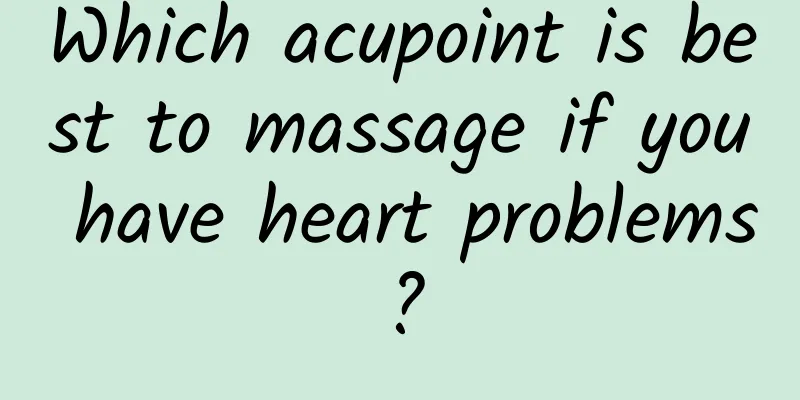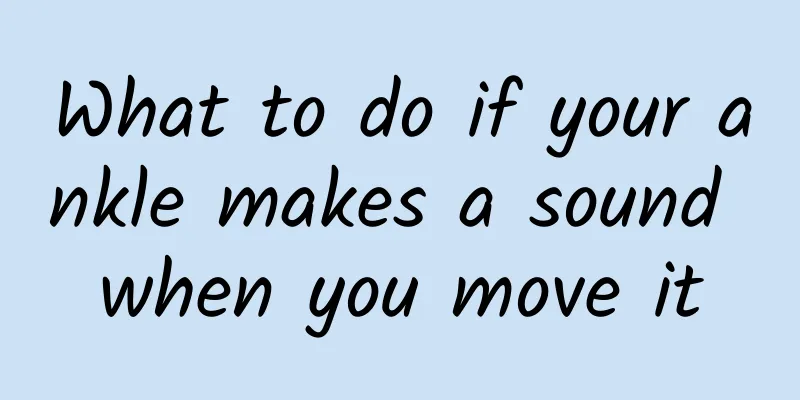A detailed explanation of acupuncture treatment methods for facial paralysis, be sure to read it!

|
The principle of TCM treatment is to achieve the purpose of treatment without damaging the root cause, so this is the principle of meridian theory. So how does acupuncture treat facial paralysis? Detailed explanation of acupuncture points Yintang Point: Located on the forehead, at the intersection of the line between the two eyebrows and the anterior midline. Massaging the Yintang acupoint can help refresh the mind, relieve headaches, and unblock blood circulation. Yangbai Point: Located on the face, directly above the pupil, about two centimeters away from the upper edge of the eyebrow. It is usually used with the temple, Jingming point, and Yuyao point to treat red, swollen and painful eyes, blurred vision, ptosis, etc. Temple: The temple is in front of the auricle, on both sides of the forehead, and above the extended line of the outer corner of the eye. In the depression behind the eyebrows. The main diseases treated by the temples are: headaches, migraines, eyestrain, toothaches and other diseases. The temple is an important acupuncture point on the human head. In "Dharma's Secret Prescription", massaging this point is listed as a "rejuvenation method", and it is believed that frequent use of this method can keep the brain youthful and reverse aging. When people use their brains for a long time, they often feel a feeling of pressure or swelling in their temples, which is a sign of brain fatigue. The effect of massage at this time will be very significant. Massaging the temples can give the brain a benign stimulation, relieve fatigue, invigorate the spirit, relieve pain, refresh the brain, and continue to maintain concentration. Sibai Point: Located on the human face, directly below the pupil, in the depression of the infraorbital foramen. When looking for this acupoint, you can first put the index fingers and middle fingers of both hands together and place them close to the sides of the nose, with the tips of the middle fingers located in the middle of the nose, which is half the length of the nose. The thumb is supported on the depression of the mandible, and then put down the middle finger. The place where the tips of the index fingers are pointing is the Sibai point. It is often used in combination with Yangbai point, Dicang point, Jiache point and Hegu point to treat facial paralysis; and with Zanzhu point to treat eyelid twitching. Yingxiang Point: Located on the human face, in the wrinkle about one centimeter away from the nose wing (next to the midpoint of the outer edge of the nose wing, in the nasolabial groove). The main diseases treated by this point are: rhinitis, nasal congestion, sinusitis, runny nose, nasal disease, toothache, cold, etc. Pressing this point can relieve toothache and also has a laxative function. Dicang Point: Located on the face, on the outer corner of the mouth, directly opposite the pupil. Cheek-Riding Point: The Cheek-Riding Point of the human body is located on the cheek, about 1 horizontal finger (middle finger) above and in front of the mandibular angle. When chewing, the masseter muscle bulges and presses the depression. To treat facial paralysis, acupuncture is usually performed on the Dicang acupoint. Chengjiang Point: Located on the human face, in the central depression of the chin-labial groove. Quanliao point: located directly below the outer canthus of the eye, in the depression at the lower edge of the zygomatic bone. It is mainly used to treat facial paralysis, eyelid twitching, red eyes, yellow eyes, toothache, facial nerve paralysis, trigeminal neuralgia, etc. Insert the needle vertically at a depth of 0.3-0.5 cun, or insert the needle obliquely or along the skin at a depth of 0.5-1 cun. Yifeng point: at the base of the ear behind the earlobe, in the depression between the mastoid process of the temporal bone and the posterior edge of the mandibular ramus of the mandible. To treat facial paralysis, you can penetrate the needle into the upper and lower parts of the front of the mandible. Hegu point: The first horizontal line of the thumb joint of one hand is facing the base of the other hand. Bend the thumb and press it down. The point where the fingertip points is the Hegu point. Hegu point belongs to the hand yangming large intestine meridian. It is a very important and useful acupoint. It is effective for facial diseases, toothache, headache, fever, dry mouth, nosebleed, neck pain, sore throat and other diseases of the five senses. However, it should be noted that patients with poor physical constitution should not be given strong stimulation, and pregnant women generally should not massage Hegu. Select acupoints based on the anatomical characteristics of the facial nerve (1) Acupuncture therapy for the facial nerve trunk: Take the affected side's Wangu, Yifeng, and below the earlobe (about 3 fen directly below the junction of the earlobe and the cheek skin. Use the fingertips to scrape up and down. If there is a rope-like object with a diameter of about 3mm and a sore and swollen feeling in the patient, it is the facial nerve trunk). For patients with a course of illness within half a month (2 weeks), moxibustion is the main treatment, using gentle moxibustion for 10 to 20 minutes each time, twice a day. For patients with a course of illness of more than half a month, acupuncture is used as the main method, using one acupoint each time, alternating between them. When piercing the acupoint below the earlobe obliquely, just twist the needle without lifting or inserting it, and leave the needle in place for 20 minutes. (2) Acupoint selection by facial nerve localization diagnosis method: This method locates the site of facial nerve damage and selects different acupoint prescriptions. ① Supranuclear facial palsy (central): This syndrome is more common in traditional Chinese medicine patients with stroke, and is not diagnosed as facial paralysis. The symptoms of facial paralysis are only a narrow mouth without eye deviation, or accompanied by hemiplegia and damage to the abducens nerve. For this type of facial paralysis, acupuncture should be performed at the end of Dui to penetrate Ju, Dicang to penetrate Jiache, Chengjiang to penetrate Daying, Yifeng, and Hegu. At the same time, a scalp needle should be applied to the lower 2/5 of the anterior temporal oblique line (i.e., the facial motor area) on the opposite side of the affected area. All facial acupoints are used for equal tonification and drainage. The head acupuncture needles are retained for 30 minutes, during which time the needles are moved twice, again for 0.5 minutes, and twisted left and right for 2 weeks each, 100 turns. ② Damage from below the mastoid foramen to the peripheral parts: This syndrome only shows simple peripheral facial paralysis. At this time, select Duiduan to penetrate Ju, Dicang to penetrate Jiache, Chengjiang to penetrate Daying, Yangbai to penetrate Yuyao, Canzhu to penetrate Sizhukong, Sibai to penetrate Chengqi, Yifeng, and Hegu. ③ Damage to the facial nerve canal to the facial nerve nucleus: This syndrome is characterized by peripheral facial paralysis and complex symptoms. The basic formula is to use Duiduan to penetrate Ju, Dicang to penetrate Jiache, Chengjiang to penetrate Daying, Yangbai to penetrate Yuyao, Zanzhu to penetrate Sizhukong, and Sibai to penetrate Chengqi. The following acupoints are then added: a. Extramedullary root segment: Symptoms include decreased taste in the anterior 2/3 of the tongue, decreased secretion of tears and saliva, and can be added with Jinjin, Yuye, Haiquan, Jingming, Zanzhu, etc. b Internal part of the petrous bone: On the basis of acupoint selection, if there is vertigo, ataxia, or hearing impairment, add head acupuncture in the dizziness and hearing area; if there is herpes in the external auditory canal, add the ear gate, hearing meeting, or hearing meeting and Wan bone. c Intramedullary root segment: Symptoms include peripheral facial paralysis, often accompanied by abducens nerve paralysis and hemiplegia on the affected side, and can be treated as central lesions. |
<<: What are the signs of cerebral thrombosis? What are the symptoms of cerebral thrombosis?
>>: What are the causes of teeth grinding? What are some tips for treating teeth grinding?
Recommend
Why are my legs suddenly more hairy?
Many people often have an inexplicable increase i...
The efficacy and function of fried morning glory seeds
I believe everyone must have seen morning glory i...
Chinese medicine formula for Sjögren's syndrome
Patients with Sjögren's syndrome need to focu...
Painful urination with blood in women
The symptoms of painful and bloody urination that...
What are the effects and functions of plantain?
In fact, everyone has often heard of plantain bec...
Treatment for gonorrhea
Gonorrhea is a very common infectious disease. Pe...
What to do if you have stomachache, acid reflux, or vomiting
Stomach pain, acid reflux, and even vomiting are ...
What to do if you can't sleep due to gum pain
Swollen and painful gums are common in life. When...
What causes sore, swollen and weak legs?
The health of the legs is extremely important for...
Saffron Grades
Saffron, also known as crocus, actually has a ver...
Can sebaceous cysts be squeezed out by themselves?
Sebaceous cyst is commonly known as cyst, which i...
What are the signs of spontaneous recovery of acute urticaria?
Many patients will ask whether acute urticaria ca...
What should I do if iron filings get into my eyes?
Eyes are a part of the body that people attach gre...
What to do if there is a hole in the middle of the tooth
In addition to colds and fevers that can cause us...
Dandelion and wolfberry for prostate treatment
Everyone knows the dandelion plant. Most people k...









